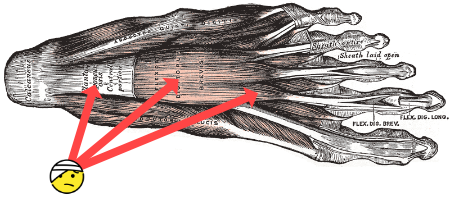If you experience sharp pain on the bottom of your feet when you first get up in the morning, after you've been sitting for a while, or after a run, you may be suffering from plantar fasciitis. You're not alone; this is one of the most common injuries in running. This post gives you the basics and explains a few simple techniques to get healthy.
First of all, it's useful to know how to properly pronounce plantar fasciitis because you will likely want to chat about it with other runners. Since dictionary pronunciation keys tend to be confusing (do you remember what sound "æ" makes?), let's do it the dumb way. You pronounce it like this: "Plan-Tar-Fash-Ee-Eye-Tus."
You pronounce it like this:
Plan-Tar-Fash-Ee-Eye-Tus
Each of your feet consist of 26 bones, 30 joints, and over 100 muscles, ligaments, and tendons. They're pretty complex. One of the harder working parts is a band of tissue called the plantar fascia, which starts at the bottom of your toes and runs all the way to your heel. The repetitive nature of running can cause this tissue to tear and become inflamed, which results in the awful, shooting pain.
This syndrome isn't exclusive to runners. It also impacts overweight people, pregnant women, those who wear shoes with poor support, and workers who spend a lot of time on their feet. In fact, plantar fasciitis is also known as "Policeman's Heel." If you are stricken, it doesn't mean your running career is over, however, you will need to change your routine and take action.

Before you commit to self diagnosis, strongly consider seeing a physical therapist. The pain and discomfort can be intense, so visiting a qualified medical professional is the best option. Just like the size of your feet, healing plantar fasciitis isn't a one-size-fits-all solution. Different people respond differently to various remedies. Here are a few things to try...
1) Stretch your feet
Before you step out of bed in the morning and endure those sharp pains, you can help your feet on their way to recovery by first giving them a dedicated stretch. Follow the example in the video above (remember, stretch from the balls of your feet, not your toes!). If you don't have the band used in the video, you can use a rolled-up towel instead.
2) Roll a massage ball under your feet

Those colorful, spiky balls aren't just for Schnauzers. Roll one under your feet for several minutes, several times a day. It isn't an immediate cure, as you will find yourself continuing this rolling process day after day, but it should gradually help ease the pain. If you don't have one of these massage balls, you can use a tennis ball or a frozen water bottle instead.
3) Stretch your calves

Muscle tightness can contribute to the pain of plantar fasciitis, and your calves can be a helpful area to focus on to get back to normal. Perform standard calf stretches like in the photo above. It's best not to do this right after you jump out of bed in the morning, though. Warm up your calves with some light foam rolling, after you've done some foot stretches and massage ball work.
4) Track your progress
![]()
It's invaluable to keep a detailed log of your injury and recovery. When you look back at your training history, you will know exactly when you had the injury, and what you did to get healthy. SportTracks is an excellent platform for documenting these setbacks with its powerful Injury Tracking features. You can track multiple injuries, record where you feel pain, adjust the severity and more. You can also track stretching sessions, keep searchable notes in your workouts, and write daily notes in your calendar.
There are more ways to relieve plantar fasciitis, but the methods explained in this post are the most simple, effective, and easily approachable. As to when you should start running again, that's up to you (and your doctor). You may feel well enough to do some easy runs after a week of steadfastly massaging and stretching, but don't push it. Always listen to your body (and your physician), and be willing to put in the time and effort required to fully recover.
| Article written by Sam Mallery, Director of Marketing, Zone Five Software Inc. |

Comments
Ok done.